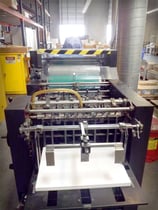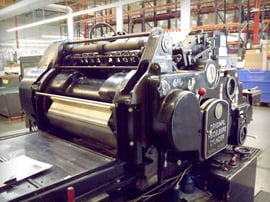Anderson has some specialty equipment on the production floor that streamline our print and mail jobs. These machines coat, stitch, perforate, and so much more, and allow us to process unique jobs in-house with efficiency and high quality. The following pictures, video, and descriptions will demonstrate our productivity in action! Here’s a bit more information about each one…
UV Coater
This machine runs cardstock paper and applies a UV coating to the outside of each sheet. Coating can be applied on one or both sides of the sheet. This creates a glossy finish. Postcards are the most typical UV coat job, as the coating makes them less likely to be damaged and bent in the mail. This process enhances the mail piece’s quality and is a very efficient way to do so!


8-Station Saddle Stitcher
The easiest way to explain the capabilities of this machine is to dissect its name. First, the “saddle” part in the name of the machine comes from the V-shape that the two sides of the booklet take when they sit on the machine with the central fold pointing upward. Each “station” on the machine can hold a section of the pages, dropping them onto the machine, saddle-style, as it runs. For a 16-page booklet we commonly run, the covers will be loaded into one station, and all the insert pages will be loaded into another. The insert pages are dropped onto the saddle in a stack, then the single-page cover is dropped from its station directly on top of them. They are then bound by the “stitch”—the staples that are applied to the spine once all the different components of the booklet have been precisely stacked on top of each other. The books are then neatly trimmed on the three open sides.
The benefits of having this capability in-house are many. First of all, it is much easier to control when each project is completed. We can print the job here, stage it to the stitcher, and have a good understanding of when it will finish running. After it is done stitching, the job can immediately be staged to a tabbing machine or wherever else on the production floor it needs to go. Stitching in-house also guarantees that the pieces will stay in the order that they were printed, making the sorting process immensely more efficient. Lastly, because we can control how fast the job runs, our machine produces fewer spoils that must be reproduced.
Check out Anderson's 8-Station Saddle Stitcher in action! http://youtu.be/9GkTT-mquXE
Heidelberg Die Cutters
Anderson has two die cutting machines which are used for perforations and scores. Perforations are a series of tiny holes in a line that allow the user to “tear here” and separate part of the paper from the rest, and scores are grooves pressed into a thick piece of paper to avoid cracking and wrinkling when folded. The folding machines in our Bindery department can do basic perforations and scores—so long as they are processed one at a time, and the piece is moving through the machine in a direction that allows it to be folded simultaneously. For any jobs where the pieces need more than one perforation or score, or where the piece is a large size or unusual shape, these die cut machines are the way to go!
Most commonly, our die cutters are used to produce sheets of coupons at the bottom of a mail piece. Perhaps the top of the mail piece will tell the recipient about the rewards they have earned, and then 16 coupons will appear below, each one outlined by a perforation that allows the recipient to tear them apart and use them individually. To do this, the machines use a die cut—custom-made for that specific art layout—which “stamps” the perforation onto the sheet in one run through the machine. In order to process a job like this, the custom die must be designed around the art and then ordered. In the right circumstances, where a custom die would be used for repeat jobs, this process helps realize efficiencies and saves the customer money in the long run.
The die cut machines can also produce perforations and scores without the creation of a custom die. For instance, let’s say we have a 3-panel self-mailer that is quite long—perhaps 27 inches—where one 9-inch panel is the reply device that can be torn away. This self-mailer is printing on very thick paper, which means it will need to be scored before it folds to avoid cracking next to the fold line. Our Heidelbergs can simultaneously score between the first two panels and perforate between the second and third. The mail pieces can then easily be moved to the folding machines, where they are folded on the score and perforation lines.
Interested in more photos of the Anderson production floor? Visit our Production Floor photo gallery at: http://on.fb.me/1oX8T9E
Want to learn more about our direct mail capabilities? Drop us a line at 888-694-5094.




